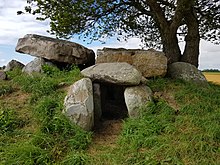Passage grave Bønnesten
The passage grave Bønnesten is located on the Danish island of Bornholm and is a large stone grave of the funnel beaker culture (TBK), which in the Neolithic between 3500 and 2800 BC. BC originated. It is one of 14 largely preserved passage graves ( Danish Jættestue ) on the island. The passage grave is a form of Neolithic megalithic systems , which consists of a chamber and a structurally separated, lateral passage. This form is primarily found in Denmark, Germany and Scandinavia, as well as occasionally in France and the Netherlands.
Description and history
Johan Andreas Jørgensen from Ibsker near Svaneke was very active as an amateur archaeologist. Numerous archaeological sites were examined and described by the Bornholm teacher in the late 19th century. In 1882 he examined the passage grave Bønnesten in the southeast of the island. The excavation of the megalithic complex produced a wealth of finds. Not far from Bønnesten, Jørgensen examined the passage grave of Stenseby six months later . In his detailed excavation report, Jørgensen summarized the two passage graves. The region is fairly flat and without rocks or stones. It has the name Stens (e) by (Steinort) only from both plants.
The trapezoidal megalithic complex, located in a round hill, consists of 11 supporting stones (originally 12), two preserved (of three) capstones and some gangue stones, including a capstone.
In 1923 Gustav Rosenberg came to Bornholm to restore the two passage graves. In this context he found a clay pot from the Bronze Age . It is not uncommon for urns to be deposited in or around stone graves in later times.
See also
literature
- Ingrid Falktoft Anderson: Vejviser til Danmarks oldtid . 1994, ISBN 87-89531-10-8 , p. 343
Individual evidence
- ↑ Andreas Peter Madsen (1822–1911) made a watercolor of the Bønnesten in 1885, which is kept in the Danish National Museum.
Web links
Coordinates: 55 ° 2 ′ 12.5 ″ N , 15 ° 3 ′ 16.2 ″ E

